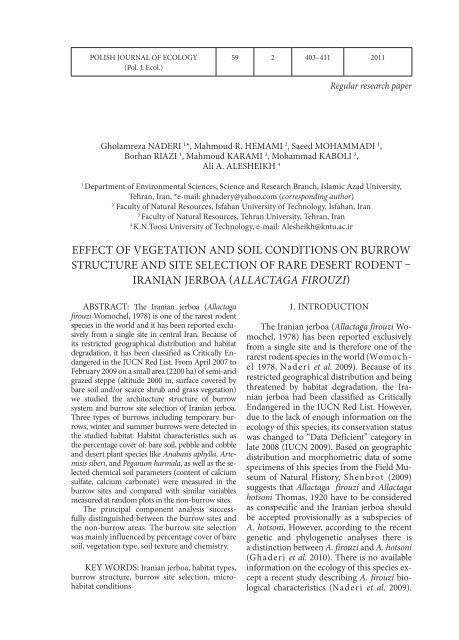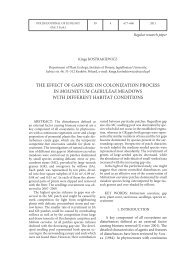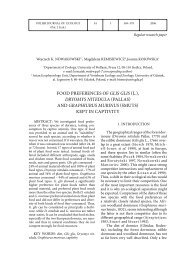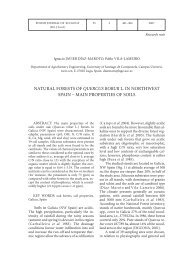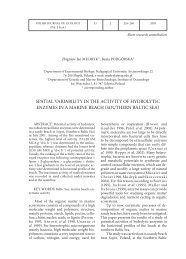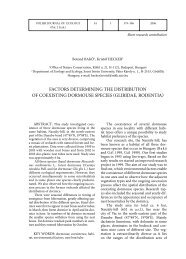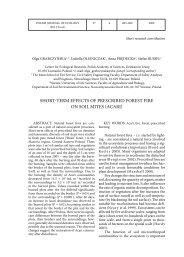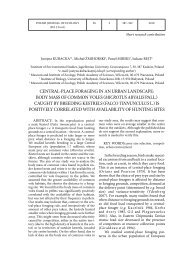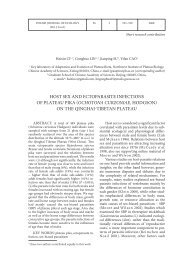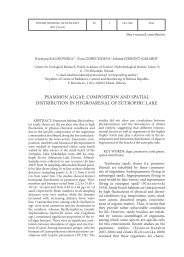EFFECT OF VEGETATION AND SOIL CONDITIONS ON BURROW ...
EFFECT OF VEGETATION AND SOIL CONDITIONS ON BURROW ...
EFFECT OF VEGETATION AND SOIL CONDITIONS ON BURROW ...
You also want an ePaper? Increase the reach of your titles
YUMPU automatically turns print PDFs into web optimized ePapers that Google loves.
POLISH JOURNAL <strong>OF</strong> ECOLOGY<br />
(Pol. J. Ecol.)<br />
59 2 403–411 2011<br />
Regular research paper<br />
Gholamreza NADERI 1 *, Mahmoud R. HEMAMI 2 , Saeed MOHAMMADI 1 ,<br />
Borhan RIAZI 1 , Mahmoud KARAMI 3 , Mohammad KABOLI 3 ,<br />
Ali A. ALESHEIKH 4<br />
1<br />
Department of Environmental Sciences, Science and Research Branch, Islamic Azad University,<br />
Tehran, Iran, *e-mail: ghnadery@yahoo.com (corresponding author)<br />
2<br />
Faculty of Natural Resources, Isfahan University of Technology, Isfahan, Iran<br />
3<br />
Faculty of Natural Resources, Tehran University, Tehran, Iran<br />
4<br />
K.N.Toosi University of Technology, e-mail: Alesheikh@kntu.ac.ir<br />
<strong>EFFECT</strong> <strong>OF</strong> <strong>VEGETATI<strong>ON</strong></strong> <strong>AND</strong> <strong>SOIL</strong> <strong>C<strong>ON</strong>DITI<strong>ON</strong>S</strong> <strong>ON</strong> <strong>BURROW</strong><br />
STRUCTURE <strong>AND</strong> SITE SELECTI<strong>ON</strong> <strong>OF</strong> RARE DESERT RODENT –<br />
IRANIAN JERBOA (ALLACTAGA FIROUZI)<br />
ABSTRACT: The Iranian jerboa (Allactaga<br />
firouzi Womochel, 1978) is one of the rarest rodent<br />
species in the world and it has been reported exclusively<br />
from a single site in central Iran. Because of<br />
its restricted geographical distribution and habitat<br />
degradation, it has been classified as Critically Endangered<br />
in the IUCN Red List. From April 2007 to<br />
February 2009 on a small area (2200 ha) of semi-arid<br />
grazed steppe (altitude 2000 m, surface covered by<br />
bare soil and/or scarce shrub and grass vegetation)<br />
we studied the architecture structure of burrow<br />
system and burrow site selection of Iranian jerboa.<br />
Three types of burrows including temporary burrows,<br />
winter and s ummer burrows were detected in<br />
the studied habitat. Habitat characteristics such as<br />
the percentage cover of: bare soil, pebble and cobble<br />
and desert plant species like Anabasis aphylla, Artemisis<br />
siberi, and Peganum harmala, as well as the selected<br />
chemical soil parameters (content of calcium<br />
sulfate, calcium carbonate) were measured in the<br />
burrow sites and compared with similar variables<br />
measured at random plots in the non-burrow sites.<br />
The principal component analysis successfully<br />
distinguished between the burrow sites and<br />
the non-burrow areas. The burrow site selection<br />
was mainly influenced by percentage cover of bare<br />
soil, vegetation type, soil texture and chemistry.<br />
KEY WORDS: Iranian jerboa, habitat types,<br />
burrow structure, burrow site selection, microhabitat<br />
conditions<br />
1. INTRODUCTI<strong>ON</strong><br />
The Iranian jerboa (Allactaga firouzi Womochel,<br />
1978) has been reported exclusively<br />
from a single site and is therefore one of the<br />
rarest rodent species in the world (Womochel<br />
1978, Naderi et al. 2009). Because of its<br />
restricted geographical distribution and being<br />
threatened by habitat degradation, the Iranian<br />
jerboa had been classified as Critically<br />
Endangered in the IUCN Red List. However,<br />
due to the lack of enough information on the<br />
ecology of this species, its conservation status<br />
was changed to “Data Deficient” category in<br />
late 2008 (IUCN 2009). Based on geographic<br />
distribution and morphometric data of some<br />
specimens of this species from the Field Museum<br />
of Natural History, Shenbrot (2009)<br />
suggests that Allactaga firouzi and Allactaga<br />
hotsoni Thomas, 1920 have to be considered<br />
as conspecific and the Iranian jerboa should<br />
be accepted provisionally as a subspecies of<br />
A. hotsoni. However, according to the recent<br />
genetic and phylogenetic analyses there is<br />
a distinction between A. firouzi and A. hotsoni<br />
(Ghaderi et al. 2010). There is no available<br />
information on the ecology of this species except<br />
a recent study describing A. firouzi biological<br />
characteristics (Naderi et al. 2009).<br />
journal 26.indb 403 2011-06-28 10:20:51
404<br />
Gholamreza Naderi et al.<br />
This study shows that Iranian jerboa is active<br />
from 11:00 pm to 05:30 am from the early<br />
spring to late summer but in midsummer its<br />
active period is restricted from 9:00 pm to<br />
4:00 am only. No individuals were observed<br />
after sunrise and before sunset. The active<br />
period of this species is much correlated with<br />
the moon rising time; so there were more individuals<br />
captured in complete darkness than<br />
after the rising of the moon. Aestivation has<br />
not been detected in the whole summer period<br />
of the field study and the hibernation started<br />
sometime late November and lasts to mid<br />
February. The breeding of this species usually<br />
occurs from April to May and the highest individual<br />
density is observed in late May. The<br />
Iranian jerboa is a good digger and runner,<br />
but it is not adapted to climbing or swimming.<br />
It digs long burrows on hard ground, using its<br />
incisors for breaking substrate, forelimbs for<br />
digging and collecting the soil under the body,<br />
hind feet for kicking the soil backward, and the<br />
snout for pushing and ramming the excavated<br />
soil. This jerboa species is well adapted to fast<br />
bipedal locomotion. The external characters<br />
of captured individuals of A. firouzi were also<br />
measured and were presented in Naderi et<br />
al. (2009; Table 1).<br />
From direct observation and inspection<br />
of food residues found in wintering burrows<br />
by Naderi at al. (2009) and in present study,<br />
we have concluded that Anabasis aphylla L.<br />
and Peganum harmala L. foliage and seeds<br />
constitute the main feeding items of Iranian<br />
jerboa.<br />
Jerboas use its burrows with a suitable<br />
microclimate as a safe refuge from predators<br />
and heat, for resting, rearing offspring,<br />
and for winter hibernation. Underground<br />
refuges, with their relatively stable microclimate,<br />
provide protection for small mammals<br />
from extreme temperatures prevailing on the<br />
surface of the desert habitats (Shenbrot et<br />
al. 2002). The common refuge type is the underground<br />
burrow, which usually varies in architecture<br />
from simple to complex structures<br />
(Hinze and Pillay 2006). Many rodent use<br />
burrow system such as Dipodillus maghrebi<br />
Schlitter and Setzer (Nel 1967), Saccostomus<br />
campestris Peters, (Ellison 1993), A. hotsoni,<br />
Allactaga williamsi Thomas, Allactaga<br />
euphratica Thomas (Ç olak and Yiğit 1998)<br />
and Meriones unguiculatus Milne-Edwards<br />
(Scheibler et al. 2006). Simple burrows<br />
comprise of a single nest chamber and one<br />
or two entrance holes (Hinze and Pillay<br />
2006). Whilst complex burrows comprise of<br />
several aboveground entrance holes joined<br />
with many interconnected tunnels belowground<br />
(Mankin and Getz 1994). These<br />
complex systems may contain one or more<br />
nesting, hoarding and nursery chambers, or<br />
a combination of these structures. The complex<br />
systems may have other functions, such<br />
as providing shelter against predators, storing<br />
food items and gaining access to high-quality<br />
feeding sites through numerous entrance<br />
holes. Ç olak and Yiğit (1998) identify four<br />
types of burrows for Allactaga elater Lichtenstein<br />
including temporary, summer, winter<br />
and reproduction burrows. The other important<br />
advantage of refuge is its use as a buffer<br />
for the animals against environmental extremities<br />
of both temperature and humidity.<br />
The studies on the habitat selection<br />
among rodents are rather numerous in the<br />
available literature (Rosenzweig 1974,<br />
1981, Morris 1987); however there is no description<br />
of burrow sites or burrow site selection<br />
especially for Allactaga genus.<br />
The information on small-mammal microhabitat<br />
utilization in burrow sites is based<br />
on straightforward standard methods usually<br />
by locating burrow stations where environmental<br />
variables are measured (e.g. L acher<br />
and Alho 1989). This technique poten-<br />
Table 1. Measurements of external characters of A. firouzi (SD – Standard Deviation, N = 126 adults;<br />
after Naderi et al. 2009<br />
Characters (mm) Mean Range ±SD<br />
Total length 309.15 269-350 12.97<br />
Head and body length 117.74 101-129 8.09<br />
Tail length 190.41 168-220 9.66<br />
Hind foot 50.10 53-59 2.24<br />
Ear 46.43 42-55 1.80<br />
Weight (g) 66.32 48-92 11.39<br />
journal 26.indb 404 2011-06-28 10:20:51
Burrow site selection of Iranian jerboa<br />
405<br />
tially does not mask subtle patterns of habitat<br />
utilization, since one doesn’t need to see or<br />
capture animals and interrupt their normal<br />
activities. Rhodes and Richmond (1983)<br />
studied the influence of soil texture on nest<br />
site selection and burrowing activity by the<br />
pine vole (Microtus pinetorum Le Conte) and<br />
concluded that soil structural characteristics<br />
have strong effect on burrow site selection.<br />
In order to elucidate the nest site selection<br />
of Iranian jerboa the underground life of<br />
this species has been investigated by 1) documenting<br />
the architecture and field characteristics<br />
of the burrow system of A. firouzi; 2)<br />
determining the effect of vegetation and soil<br />
conditions on the selection of burrow sites by<br />
this species.<br />
2. STUDY AREA<br />
The study was conducted from April<br />
2007 to February 2009, in a small area of<br />
semi-arid steppe (2200 ha) located 20 km<br />
south of Shahreza, Iran (31°56’–31°43’N and<br />
51°53’–52°02’E). The area has an altitude of<br />
about 2000 m a.s.l. and the climate which is<br />
markedly seasonal with a dry season between<br />
May and September (
406<br />
Gholamreza Naderi et al.<br />
Table 2. Mean (SD) values of physical characteristics of 15 burrow systems (Fig. 1) of A. firouzi.<br />
summer burrow<br />
(N = 5)<br />
winter burrow<br />
(N = 5)<br />
temporary burrow<br />
(N = 5)<br />
Feature Mean SD Mean SD Mean SD<br />
Length (cm) 109 19.27 363.80 111.94 72.20 14.61<br />
Number of entrance holes 2.60 0.54 5.20 1.30 1.20 0.44<br />
Depth of nest chamber<br />
(cm)<br />
59.60 8.29 84.20 9.03 41.20 9.78<br />
Number of dead ends 0.71 0.91 2.61 1.35 0.54 0.25<br />
meter to the nearest 0.5 cm. Further burrow<br />
systems were not excavated, to minimize disturbance<br />
to the studied population.<br />
3.2. Burrow site selection<br />
The burrow densities were studied in four<br />
habitat types (see the Study area) via random<br />
transects. For identifying the burrows in the<br />
study area different methods were used including<br />
for example following the individuals<br />
in the late activity period at night, searching<br />
for unbound previous year burrows and looking<br />
for plugged soil with different colours and<br />
humidity from ambient soil. In each habitat<br />
type, the burrow numbers were counted in 36<br />
random transects (transect length = 2 km).<br />
The microhabitat variables were measured<br />
in 66 burrow plots (presence) and the same<br />
number of the non-burrow plots (paired<br />
plots) (absence). The paired plots were selected<br />
randomly in about 500 meters away from<br />
the burrow plots (Naderi et al. 2009).<br />
In each habitat type a 10 × 10 m square<br />
area surrounding the sampling points was<br />
plotted (e.g. burrows in burrow plots) and the<br />
following microhabitat variables were measured:<br />
BSC – bare soil percent, PEB – cover<br />
pebble cover, COB – cobble percent cover,<br />
AAC, PHC and ASC respectively for the percent<br />
cover of A. aphylla, P. harmala and A. siberi.<br />
The percentage of canopy cover at crown<br />
level was estimated with the aid of a squared<br />
hard paper frame (25 × 25 cm). The arithmetic<br />
mean of the measurements of each variable<br />
was considered as the variables for the<br />
burrow plots and the paired (non-burrow )<br />
plots. A one kg soi l sample was taken from<br />
the centre of each plot for laboratory analysis<br />
of soil texture and of content of CaCO 3<br />
,<br />
CaSO 4<br />
, sand, pebble, silt and clay. Soil properties<br />
were studied independently of other<br />
mentioned microhabitats.<br />
3.3. Data analysis<br />
Structural differences in burrow systems<br />
a nd significant differences in burrow density<br />
was determined by ANOVA. A Two-way<br />
ANOVA was used to compare microhabitat<br />
variables between burrow and paired (nonborrow)<br />
plots across the whole study area<br />
with habitat type and the presence versus<br />
the absence of the burrows as fixed factors.<br />
The principal component analysis (PCA) was<br />
used to determine the most influential microhabitat<br />
variables (including BSC, AAC, ASC,<br />
PHC, PEB and COB) on the burrow site selection.<br />
To determine important microhabitat<br />
characteristics for burrow site selection<br />
within each habitat type, a paired t-test was<br />
used to compare microhabitat variables measured<br />
in burrow plots and paired (non- burrow)<br />
plots.<br />
The 66 soil samples from the burrow<br />
presence plots were compared with the same<br />
number from the paired plots (non-burrow<br />
plots) by applying dependent t-student test.<br />
The SPSS 16.0 statistical package was used for<br />
statistical analysis.<br />
4. RESULTS<br />
4.1. Structure of burrow systems<br />
The number of entrance holes in the excavated<br />
burrows ranged from one to nine per<br />
system and the number of tunnels ranged<br />
from 2 to 15, depending on the burrow system.<br />
The temporary burrow represents the<br />
simplest type which functions as an escape<br />
burrow (Fig. 1). These burrows have one nest<br />
chamber and a few (1–2) entrance holes per<br />
each burrow. The length of the system was<br />
smaller than in the summer or winter burrows.<br />
The summer burrows contained one<br />
nest chamber with a total length ranging from<br />
journal 26.indb 406 2011-06-28 10:20:52
Burrow site selection of Iranian jerboa<br />
407<br />
one to three meters. The length of the burrow<br />
may reach 4 ± 1.1 m, ending in a spherical<br />
nest chamber of 3.5 cm in diameter, and descending<br />
gradually to as deep as 23 cm without<br />
branching (Table 2). There was no stored<br />
food at the nest chamber, during the observation<br />
but dry stems and seeds of A. aphylla and<br />
P. harmala were found only in tunnels. This<br />
suggests that tunnel material may periodically<br />
be cleaned out and replaced with fresh<br />
material. This type of burrows was generally<br />
observed in the bare soil habitat type. Winter<br />
burrows contained a single nest chamber at<br />
various depths with the nest chambers had<br />
been dug deeper than both summer and temporary<br />
burrows (Fig. 1).<br />
ANOVA showed that the mean length<br />
of tunnels in winter burrows is greater<br />
(P
408<br />
Gholamreza Naderi et al.<br />
Table 4. Paired T- test analysis of results for burrow and (paired) non-burrow plots (in brackets: SE –<br />
standard error of the mean, df – degree of freedom). Percent cover of bare soil – BSC, of cobble – COB,<br />
of pebble – PEB, of A. aphylla – AAC, of A. siberi – ASC and of P. harmala – PHC. Asterisks show significant<br />
(P
Burrow site selection of Iranian jerboa<br />
409<br />
5. DISCUSSI<strong>ON</strong><br />
Iranian jerboa creates three separate types<br />
of burr ow: temporary, summer and winter<br />
burrows. All of these burrows had a nest<br />
chamber but without feeding chamber and<br />
winter burrows had a larger surface area and<br />
were deeper. In general, the burrow system<br />
described by Ç olak and Yiğit (1998) for<br />
A. elater was similar with the above described<br />
types of burrows except for the reproduction<br />
burrow. Scheibler et al. (2006) identify<br />
three types of burrow for Mongolian gerbil<br />
(M. unguiculatus) including summer, reproduction<br />
and winter burrows. The temporary<br />
burrows are plain tubes which are used to<br />
escape from predators during the night. This<br />
burrow was found to be similar with the temporary<br />
burrow system of A. elater but they are<br />
differed in their structures. No marked nest<br />
chamber was reported for temporary burrow<br />
of A. elater (Ç olak and Yiğit 1998).<br />
As Mankin and Getz (1994) reported that<br />
escape burrows, although slightly smaller<br />
than nesting burrows, had numerous (2–9)<br />
entrance holes to allow for a rapid entry or<br />
exit. There are however no reported data on<br />
the relationship between architecture of burrows<br />
and the social organization of A. firouzi.<br />
The summer burrows were observed to have<br />
a single nesting chamber and according to<br />
Ç olak and Yiğit (1998) there are two types<br />
of summer burrows for A. elater: one had<br />
a lateral passage leading to the surface other<br />
than the main gallery and the second one was<br />
a burrow with a single exit.<br />
We can say that, especially with regard to<br />
burrow site selection, Iranian jerboa is a microhabitat<br />
specialist and relies primarily on<br />
structural characteristics of its environment to<br />
select sites for burrow construction. Our results<br />
are in agreement with the general pattern<br />
described for most species of five-toed jerboas<br />
that use habitats which are characterized by<br />
hard soil and sparse vegetation (Shenbrot et<br />
al. 2008). There is no published information<br />
about burrow site selection of Allactaga species<br />
but some relatively similar findings for<br />
their habitat selection had been reported. For<br />
example, according to Brown (1980) A. hotsoni<br />
was caught in barren areas and there is<br />
a negative correlation between the percentage<br />
vegetation cover and the Hotson’s Jerboa<br />
occurrence. He also found a significant correlation<br />
between the occurrence of A. hotsoni<br />
and the halophytic chenopod, Seidlitzia rosmarinus<br />
Bunge. The investigation of habitat<br />
associations of A. firouzi (Naderi et al. 2009)<br />
showed that the overall pattern of habitat selection<br />
of this species is different from the pattern<br />
of burrow site selection. A. firouzi select<br />
Anabasis type for its activity out of the burrows<br />
but it selects bare and unvegetated areas<br />
for burrow construction. Our results are<br />
in agreement with other studies about the<br />
habitat selection of A. hotsoni (Brown 1980),<br />
Fig. 4. Percent content of different measured soil variables in burrow sites (punctuate bars) and nonburrow<br />
(paired) plots (white bars; standard deviation is given on the top of each bar).<br />
journal 26.indb 409 2011-06-28 10:20:54
410<br />
Gholamreza Naderi et al.<br />
Pygerethmus pumilio Kerr (Shenbrot 1992,<br />
Shenbrot and Rogovin 1995) and Allactaga<br />
bullata Allen (Rogovin and Shenbrot<br />
1995). The association of small rodents with<br />
vegetation variables that provide greater cover<br />
has a lso been shown in other studies (Murúa<br />
and González 1982 and Shenbrot 2004).<br />
Our study is in agreement with this pattern,<br />
that the species seemed to prefer areas with<br />
highly uncovered than covered surfaces,<br />
which are probably related with the protection<br />
against the predators. Indeed the adaptation<br />
value of preferring bare soil cover most likely<br />
results from the possibility for better and faster<br />
entering to the burrows. Iranian Jerboa is<br />
also known to feed on A. aphylla plant matter<br />
(Naderi et al. 2009). Therefore, this species<br />
preferred locations with high food availability<br />
(Anabasis type) as well as enough uncovered<br />
soil especially in wintering burrows. As<br />
shown, microhabitat features are different in<br />
burrow sites from other parts of the habitat.<br />
As Simonetti (1989) reveals that food, predation,<br />
and microhabitat structure were the<br />
proximate factors shaping the selection of<br />
microhabitats. Selecting areas with relatively<br />
high CaCO 3<br />
percentage in soil is necessary<br />
for the burrow stability which is presumed to<br />
be better in harder soil, as it is especially. In<br />
conclusion, we can say that some microhabitat<br />
variables such as the extent of the cover<br />
of A. aphylla and P. harmala (which are related<br />
to feeding grounds) and bare soils cover<br />
(which are related to anti-predator behaviour<br />
with regard to rapid escaping) are the most influential<br />
variables in habitat use by the Iranian<br />
jerboa.<br />
ACKNOWLEDGMENTS: We would like<br />
to t hank Dr Aliakbar Naderi who helped us in<br />
field work. We thank Dr Shenbrot, Dr Katakweba<br />
and Dr Hashim Mohammad for valuable<br />
comments on the earlier draft of the manuscript.<br />
Anonymous reviewer and Professor Anna Hillbricht-Ilkowska,<br />
editorial office of Polish Journal<br />
of Ecology provided useful comments.<br />
6. REFERENCES<br />
Brown R.E. 1980 – Rodents of the Kavir National<br />
Park, Iran – Mammalia, 44: 89–96.<br />
Çolak E., Yiğit N. 1998 – Ecology and biology<br />
of Allactaga elater, Allactaga euphratica and<br />
Allactaga williamsi (Rodentia: Dipodidae) in<br />
Turkey – Tur. J. Zool. 22: 105–117.<br />
Ellison G.T.H. 1993 – Group size, burrow<br />
structure and hoarding activity of pouched<br />
mice (Saccostomus campestris: Cricetidae) in<br />
southern Africa – Afr. J. Zool. 31: 135–155.<br />
Ghaderi F., Malekian M., Hemami<br />
M.R., Nasr-Esfahani M., Hosseini,<br />
M. Fazilati 2010 – On the conspecificity of<br />
Iranian and Hotson’s Jerboas (Paper presented<br />
at the 4 th International Conference of Biology,<br />
Ferdosi University, Mashhad, Iran).<br />
Hinz A., Pillay N. 2006 – Life in an African<br />
alpine habitat: activity patterns of the ice rat<br />
Otomys sloggetti robertsi – Arct. Antarct. Alp.<br />
Res. 38: 540–546.<br />
IUCN 2009 – IUCN Red List of Threatened Species.<br />
Version 2009.2. .<br />
Lacher E.JR., C.J.R. Alho 1989 – Microhabitat<br />
use among small mammals in the Brazilian<br />
Pantanal – J. Mammal. 70: 396–401.<br />
Mankin P.C., Getz L.L. 1994 – Burrow morphology<br />
as related to social organization of<br />
Micotus ochrogaster – J. Mammal. 75: 492–499.<br />
Morris D.W. 1987 – Ecological scale and habitat<br />
use – Ecology, 68: 362–369.<br />
Murua R., Gonzalez L.A. 1982 – Microhabitat<br />
selection in two Chilean cricetid rodents –<br />
Oecologia, 52: 12–15.<br />
Naderi Gh, Hemami M.R., Riazi B.,<br />
Alesheikh A. 2009 – Notes on ecological<br />
peculiarities of Iranian Jerboa, Allactaga firouzi<br />
Womochel, 1978 (Mammalia: Dipodidae)<br />
– Zool. Middle East, 47: 21–28.<br />
Nel J.A.J. 1967 – Burrow systems of Desmodilus<br />
auricularis in the Kalahari Gemsbok National<br />
Park – Koedoe, 10: 118–121.<br />
Rhodes D.H., Richmond M.E. 1983 – The<br />
influence of soil moisture, texture and temperature<br />
on nest site selection and burrowing<br />
activity by Pine vole – Wildlife Damage Management,<br />
Internet Center for Eastern Pine and<br />
Meadow Vole Symposia, University of Nebraska-Lincoln.<br />
Rogovin K.A., Shenbrot G.I. 1995 – Geographical<br />
ecology of Mongolian desert rodent<br />
communities – J. Biogeogr. 22: 1163–1180.<br />
Rosenzweig M.L. 1981 – A theory of habitat<br />
selection – Ecology, 62: 327–335.<br />
Rosenzweig M.L. 1974 – On the evolution of<br />
habitat selection (In: Proc. 1 st Intern. Congress<br />
of Ecology), pp. 401–404.<br />
Scheibler E., Liu W., Weinandy R., Gattermann<br />
R . 2006 – Burrow systems of the<br />
Mongolian gerbil (Meriones unguiculatus<br />
Milne Edwards, 1867). Mammalian Biology<br />
– Zeitschrift fur Saugetierkunde, 71:<br />
178–182.<br />
journal 26.indb 410 2011-06-28 10:20:55
Burrow site selection of Iranian jerboa<br />
411<br />
Shenbrot G. 1992 – Spatial structure and niche<br />
patterns of a rodent community in the south<br />
Bukhara desert (Middle Asia) – Ecography, 15:<br />
347–357.<br />
Shenbrot G. 2004 – Habitat selection in a seasonally<br />
variable environment: Test of the isodar<br />
theory with the fat sand rat, Psammomys<br />
obesus, in the Negev – Oikos, 106: 359–365.<br />
Shenbrot G.I. 2009 – On the conspecifity of<br />
Allactaga hotsoni Thomas, 1920 and Allactaga<br />
firouzi Womochel, 1978 (Rodentia: Dipodidae)<br />
– Mammalia, 73: 241–237.<br />
Shenbrot G.I., Rogovin K.A. 1995 – Temporal<br />
variation in spatial organization of a rodent<br />
community in the southwestern Kyzylkum<br />
Desert (Middle Asia) – Ecography, 18:<br />
370–383.<br />
Shenbrot G.I., Sokolov V.E., Heptner<br />
V.G., Kowalskaya Y.M. 2008 – Jerboas.<br />
Mammals of Russia and adjacent regions –<br />
Science Publishers Inc, May St, PO Box 699,<br />
Enfield, NH 03748 USA, 786 pp.<br />
Shenbrot G.; Krasnov B.; Khokhlova I.,<br />
Demidova T., Fielden L. 2002 – Habitatdependent<br />
differences in architecture and microclimate<br />
of the burrows of Sundevall’s jird (Meriones<br />
crassus) (Rodentia: Gerbillinae) in the Negev<br />
Desert, Israel – J. Arid Environ. 51: 265–279.<br />
Simonetti J.A. 1989 – Microhabitat use by<br />
small mammals in central Chile – Oikos, 56:<br />
309–318.<br />
Womochel D.R . 1978 – A new species of Allactaga<br />
(Rodentia: Dipodidae) from Iran – Fieldiana<br />
Zoology, 72: 65–73.<br />
Received after revision July 2010<br />
journal 26.indb 411 2011-06-28 10:20:55


